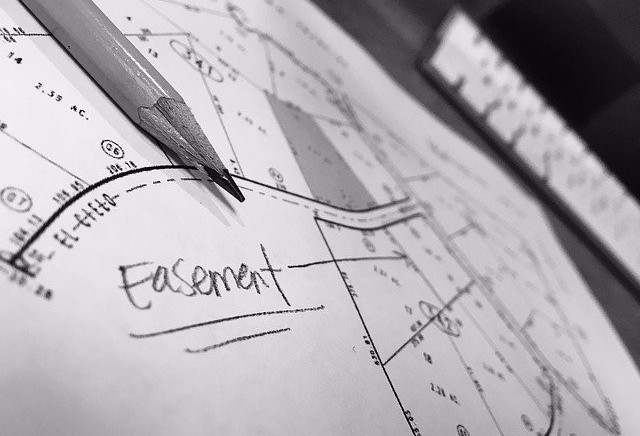In this article, we will be looking into defining easement on a property, especially in the perspective of property investors and property developers. However, before answering the question ‘what is an Easement on a property?, let’s get our heads around the types of properties, and their legal context.
What is a Property?
Apart from man’s quest for many powers, property acquisition has been one of man’s most desired quest. Property as regards to man, are valuables or anything owned by an individual, public or group of the people, of which they have legal title over. These properties are maybe incorporeal or physical properties.
A property owner or corporation has several rights over the things they posses ranging from right to rent, consume, sell, transfer ownership, giveaway, mortgage, pawn, exchange, and also the owner has the right to destroy the property(ies). The owner also has the right to develop, keep or abandon his/her property(ies). We must also acknowledge that these rights solely depends on the nature of the property, either physical or incorporeal.
- Physical properties
which is also referred to as tangible properties, refers to anything possessed by man which can be felt or touched, this also includes real properties and also personal properties, which also has almost the same value as intangible properties.
Physical properties (tangible properties) are also referred to as a chose in possession by the common law legal system and some other common health legal system.
There are some properties, which are physical in nature, but are classified as intangible properties in many legal systems. This is because the legal rights attached to the physical property are of much more value than the physical property itself. A promissory note is a good example of the above explanation.
A promissory note refers to a legal document which binds two parties into an agreement, thereby enforcing the promise of one party (borrower) to pay up his debt to the other party (the lender) within an agreed period of time. This agreement is written on a piece of paper, but it bears so much legal rights.
- Incorporeal properties (intangible properties)
This refers to the things which are Insubstantial, immaterial, financial or intangible in nature but are possessed by man, and can also be transferred to person or group of people (corporation). These incorporeal properties maybe include brand names and also intellectual properties (IP).
Intellectual properties (IP) includes trademarks, trade secrets, patent, and copyrights. These are insubstantial products of man’s intellect and are highly recognized and valued in many countries in the world.
Back in the 19th century the term “intellectual property” came into official existence, and by the 20th century, it became popular in the legal systems of many countries.
The main reason for the “intellectual property law” was to influence the development of intellectual goods of different varieties.
Incorporeal properties which are also referred to as “chose in action”, are of two classifications: legal incorporeal property and competitive incorporeal property. While legal incorporeal properties are the above discussed, competitive incorporeal properties are referred to as the origin of the legal incorporeal properties which are created. Still, they can’t be transferred, owned or destroyed.
Below are a few popular types of incorporeal properties.
- Licenses
- Goodwill
- Patents
- Rights
- Brand equity
- Customer lists
- Trademarks
- Research and development
- Copyrights.
From the above exposition on properties and property types, we may have learnt that only the property owner has the right to use, develop, keep, sell or destroy his/her property depending on the nature of the property in question.
However, there is a situation whereby the usage of properties or a particular property by the sole owner may be completely or slightly altered by another person or group of people. This takes us to the question below.
What is an Easement?
The easement is a legal term which offers one the right to make use of another person rightfully owned property, for a specified period of time and for a particular purpose, with the required easement regulations. Easements give one the temporal right to use a property, but the sole owner still retains the ownership of the property.
For example: if a landowner Mr. A allows the neighbor Mr. B to make use of his own private path or portion of his land for navigating to his (the neighbors) land. In this case, Mr. A granted an easement to Mr. B, who is the benefactor of the easement.
Public and private utility properties like cables and power lines are also common and regular easements, we come across nearly all the time. This goes to show that easements can be granted to anybody, this includes private individuals, neighbors
and government agencies.
The real property law governs easements, this is because easements are in concordance with real properties.
There are easement rights issued to an easement beneficiary, and these rights vary depending on the legal judgment and decision-making institutions country to country. History says, there are 4 common types of easement rights which are usually enforced by the law courts.
They are:
- Easement rights of way.
- Easement rights to artificial waterways.
- Light and air easements.
- Easements of support (as regards to excavations).
Although modern courts now recognize new and different easement rights, they all fall under the 4 above-mentioned easement rights which makes up the easement law foundation.
This video explains the differences between easements and rights of way.
Tip: You need to be mindful of easements when planning to subdivide land as we noted in our guide to safer stat to real estate developments.
How To Find Out If There is an Easement on your Property?
Easements may be issued to anybody either an individual or group of people at the expense of the property owner. The city council is good place to make inquiries about easements on your property.
Public utility easements like power lines are recorded and identified with your local utility companies or board.
County Land Records Office (or Land Title Office) are also good options in ascertaining easements on your property.
Types of Easements
The recognition of the several easement types depends on the different states and the real property laws of that state.
1. Affirmative and negative easements
An affirmative easement is an easement right that allows you to make use of someone’s property for a particular purpose and duration.
An example of an affirmative easement is a situation where Mr. A allows Mr. B has an affirmed right from Mr. A to make use of his land for navigation.
Meanwhile, the easement is an easement right which restricts the main property owner from using his/her property in a way he/her choose to. This gives the easement beneficiary a negative right from the real property owner. Moreover, negative easements are addressed as restrictive covenants or agreement which is normally recorded in the deed.
Negative easements are usually made by sealing legal document like a deed or private contracts. Though sometimes easements are observed even without legal writing or recognition, it is important easements are properly and clearly documented with the necessary legal requirements also put in place.
2. Private and public easements
Private easements refer to easements granted to an individual and private corporation. While public easements issue the public the right to make use of a property belonging to an individual.
3. Prescriptive easements
Prescriptive easements also referred to as easement by Prescription implies an easement issued someone over another’s property (Land) for a specified purpose and duration.
Different legal law systems have rules guiding the issuing of Prescriptive easements and the purpose and time limit of such easement. The legal law system may also determine if the easement beneficiary should also partake in the payment of some portion of the property taxes.
4. Easement by necessity
This easement type implies to situations whereby a property owner must pass through another’s land or path in order to access his or her own property.
Cases like this have always been one of the main challenges and easement disputes and fear of impending challenges, the court thereby issues and determines proper enforcement of easements by necessity.
Easements by necessity impose a burden on the property owner issuing the easement, thereby creating an advantage to the beneficiary, the court would consider both parties appropriately before issuing or enforcing such easement. The easement might still be terminated in cases where a new avenue has been created for the beneficiary to access himself property.
There is also a similar easement which is referred to as easement by implication. This type of easement arises when there is a reasonable reason to make use of another’s property.
NB: Easement by implication (implied easement) is an unwritten form of easement. Therefore, it is not recognized by the legal system.
5. Easement by prior use
Easement by prior use is an easement triggered when an individual or party owns two proper but later sold or transfers the ownership of one of the properties to another party, but initially used a part of the property. These easements normally don’t reflect on the deed, so it’s also known as a quasi-easement.
6. Conservative Easement
Conservative restriction, conservative convenient or conservative servitude is another way to address a conservative easement. It is referred to as the power of the government or recognized land trust (a private land conservation organization) to regulate or restrict the landowners right in a designated area, in order to protect and conserve the value of the property. It is a legal agreement between both parties.
7. Recreational easement
The development and quest of man for leisure and recreational activities triggered the government into issuing easement for recreational arenas and leisure packs.
8. Easement appurtenance
An easement appurtenant is an easement which gives the property owner the right to make use of part of the neighbor’s land for navigating to his own plot.
What Does It Mean If I Have an Easement on My Property?
This is a very good question.
As a property owner, it is right that you make inquiries on the property you acquired or was transferred to you, as to ascertain if your property has an easement recorded with the county clerk or maybe an implied easement.
Having an easement on your property means a lot, most times a property with an easement might be more of a burden to the property owner. The effects of an easement on your property depend on the types of easement placed on the property.
Easement like utility easement is more of a benefit to the property owner and the public in general. This doesn’t give the body an easement on your issues a utility right to an individual or corporation over your property or part of your property.
Moreover, a negative easement on a property is an easement which implies that the real property owner doesn’t have full right over his activities or utility of his property. Property owner restrictive easement is of a negative impact and loss to the real property owner.
From the above mentioned, it would be advisable you go through the property and also inspect the easement document in order to know what types of easement that has been placed on the property. This would help you make a decision and also keep you informed the nature of the property in your possession.
Would an Easement Reduce the Property Value?
Not really.
The effect of an easement on your property depends on the nature of the easement there are easements like “common easement” which gives the property owner issuing or granting an easement the right to benefit from proceeds of the easement. These types of easements are also known as the “non-exclusive easement“.
Sometimes a property which has an easement tends to have lesser value than that of the beneficiary property. This affects the value of the property bearing the burden (easement) and may affect the value of that property in the near future when the real owner decides to cash in on the property.
For example, if Mr. A has two properties which he plans to sell, and Mr. B is the customer interested in buying the properties. After going through the legal documentation of the two properties, and finds out that one of them bears a negative easement, he might decide not to buy that particular property because of the nature of the easement placed on that property. In this situation, the property in question has low value than the other property which doesn’t have an easement of such nature placed on them.
In essence, the terms and types of easements go a long way in the determination of the extent to which the value of the property is being affected.
Common Disputes Scenarios Over Easement
Sometimes the issuing of an easement or improper utility of the granted easement may cause disputes, which may lead to fighting over properties by the parties involved. Below are common dispute scenarios which may amount as a result of easements.
1. Unauthorized possession
Unauthorized possession involves a situation where someone claims ownership over a property which rightfully and legally doesn’t belong to him/her. This might be a case where someone mistakenly takes over a small portion of the real owners’ property, or intentionally claims an undeveloped or abandoned property.
2. Encroaching someone’s property
Disputes like this normally arise when a landowner crosses his or her own boundaries, thereby tampering with his neighbors’ portion of land.
Cases like this are considered as “private nuisance” and the property owners whose rights were violated in such manner, has the right to sue the offenders and also stand a chance of being compensated via a legal process.
3. Going against the covenants of a particular area or property
Disputes like this usually occur in a situation where the property owners might be restricted on their activities on such properties.
A covenant here, refers to legal agreements written and signed on the deeds of the property.
4. Defection in-deed
sometimes there may be mistakes and inaccuracy in the property description recorded in the deed. This may cause disputes over time if it’s not handled properly.
NB: these easement disputes can be settled amicably by the parties involved, the property regulatory agencies or the legal system (the judiciary).
Summary
An easement on properties grants one the legal right to make use of the property (ies) belonging to another, for a specific purpose, within a specified period of time.
Easements on properties may affect the property value either positively or negatively, depending on the nature of the easement. Disputes may also arise during the settlement or the utility of easements. These disputes can be settled or resolved by the parties involved, the cooperation of the body managing the property and also the legal court.






Recent Comments